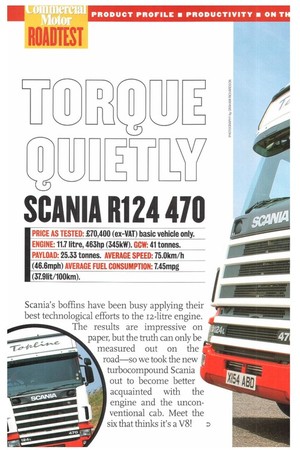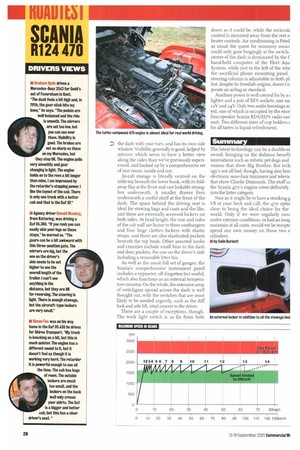=NIA R124 470
Page 24

Page 26

Page 27

Page 28

If you've noticed an error in this article please click here to report it so we can fix it.
IPRICE AS TESTED: £70,400 (ex-VAT) basic vehicle only. ENGINE: 11.7 litre, 463hp (345kW). GCW: 41 tonnes. PAYLOAD: 25.33 tonnes. AVERAGE SPEED: 75.0km/h MEM (46.6mph) AVERAGE FUEL CONSUMPTION: 7.45mpg (37.91it/100km).
Scania's boffins have been busy applying their best technological efforts to the 12-litre engine. The results are impressive on paper, but the truth can only be measured out on the road—so we took the new turbocompound Scania out to become better acquainted with the engine and the unconventional cab. Meet the
six that thinks it's a V8! D
0 f the Euro-3 emission standard is to be remembered for anything, it will be for delivering the final blow in the long-drawn-out death of the low-tech engine. Ever since Bosch converted Rudolf Diesel's principles into a practical system in the Twenties, the mechanically controlled fuel-injection system has changed little. But the level of cleaner combustion needed to meet the demands of Euro-3 has finally reached the point where only electronics can provide the necessary degree of control—tolerances that the pioneers could never have dreamed of.
The finest brains in the industry are engaged in a never-ending effort to match the seemingly irreconcilable goals of lower emissions and more power without using significantly more fuel. To achieve this, each company is picking from a finite selection of techniques. Scania's latest effort is basically no different, although its chosen recipe does have a flavour all of its own, thanks to a dash of turbo-compounding, an ingredient at present unique to the Swedes.
Product profile
We described the technology behind the new 470 engine when we first drove it (CM 22-29 February); but to recap briefly, it uses a high pressure injection (H P1) system developed in association with Cummins. The engine actually has two fuel circuits, one providing the fuel for combustion and the other acting as an electronically managed hydraulic system controlling the injection timing and quantity. Open-nozzle injectors permit a gradual onset of injection, which benefits noise levels.
The 470 is the first engine, but certainly not the last, to feature Scania's in-house engine management electronics, while the third weapon in its armoury is the latest version of the turbo-compound system. Mounted downstream of the conventional turbocharger, this uses some of the remaining energy in the exhaust gas to spin a second turbine. The rotation is transmitted back into the flywheel by way of an hydraulic coupling, like a mini torque converter, and a reduction g Scania's figures indicate about 3% of enE power is reclaimed. A welcome by-produc turbo-compounding is that by the time exhaust gas has powered two sets of turbil it barely has the energy to drop out of the of the pipe, never mind make any noise.
The sum total of all this wizardry is engine that has the weight and comi dimensions of the current i2.-litre six-pot with a torque output similar to the old 53( 14-litre V8. On the emissions front it comf ably meets Euro-3 and, with the likely addii of exhaust gas recirculation, will be up to challenge of Euro-4 as well.
Starting at the t2-litre 420, the top em Scania's line-up now goes on to our 470 at extra cost of about £5,500. Another L3,-, buys the i6-litre V8 480, while the range-I ping 58o adds a further £3,800. The natt comparison is between the 470 and units. Apart from the obvious fohp, the offers an extra looNm of torque. albeit ow -ower speed range, the same specific fuel mmption and an extra 3okW of exhaust :e power. Against this, the six-pot weighs about 250kg less. You pays your money...
OdUCtiVity
mmmary of the then all-new Scania 580 5-ii October z000), our first Euro-3 cornnt test subject, praised the V8-engined ship both for its easy performance and for 'uel consumption. The performance was .1...ted, of course, but the economy was a sant surprise.
he 470 was just as surprising in its own We were expecting that a highly efficient irte should produce good fuel results, and were not disappointed. Intriguingly, all ,e Euro-3 tractors that we've tested so far
been within o.itnpg of each other. So ough at 7.mpg overall the Scania 470 is worst of the three so far, that deficit ates to just one gallon over three days! /here we didn't expect the result that we ieved was in the journey times. The averspeed over the whole trip was just n the road p gear to Perth"—could be the title of a el book, but in fact it's the story of our rney north from Birmingham. The first ent to demand any intervention from the r lever was the Forteviot hillclimb on the , five miles shy of Perth, which took two rts. Until then the greatest challenge had Ii Beattock on the A74 (M), which dragged revs down to the bottom of the green Shap having been taken on the limiter. the A68, with its short, sharp killer nbs, the only time low range was needed 3 when we inadvertently changed from a to sixth on the steepest part of Caslleside, I even then the 470 recovered without ning to a halt. or much of the time driving is literally a 3ertip affair, as the retarder speed hold and he control resume buttons are pressed in n. The powerful retarder has three meth; of operation. It can be activated by the first t of the foot brake's travel, by using the sixge control lever, the last stage of which also operates the exhaust brake, or by simply pressing the end of the lever to hold the current speed. That lever, incidentally, represents one of Scania's few ergonomic mistakes. Its mounting panel's wholesale move across the cab for RHD leaves the lever tucked awkwardly behind the steering wheel rim, whereas a mirror-image panel would give a useful couple of inches of extra clearance. The high-tech engine means the 470 is eerily quiet, to the point that the occasional helping of wind noise from the front top corners of the cab means you can't hear what the engine is doing, The Scania's ride was surprisingly firm, with the steel front suspension occasionally being caught out by the worst surfaces, although the excellent cab and seat suspension meant little got through to the driver. The upside is that the steering conveys exactly what's going on down below, so that you can almost tell the sex of the rabbits as you run them over (kidding!). On the rare occasions that the all-disc service brakes are needed, they stop the 41 tonnes in a distance that would be quite acceptable for a modern car. Cab comfort No-one could accuse Scania of bowing to convention with the Topline cab. From the aerodynamic foldaway lower step to the once controversial forward-mounted upper bunk, Scania does things its own way. This was the first time your tester had sampled that bunk, but the anticipated claustrophobia didn't appear. Indeed, the huge bunk is wide enough to sleep two at a pinch, although the lack of headroom means it can only be side by side. The lack of any restraint apart from the lip at the edge of the bunk is a bit unnerving, but apparently the lip works. Access via the folding ladder is definitely an acquired skill, though, as your head reaches the roof while your feet are still a good yard down the ladder. Another ergonomic blunder is that the conveniently located switch panel for heating, lighting and locking is at the opposite end to the reading lamp. Which activity you're meant to carry out with your toes is not obvious. Back at floor level, some critics have slated the Topline for not having a level deck. But even above the engine tunnel there is more than enough head room for a six-footer, and the benefit comes in the form of easier cab access. Other critics have had a go at Scania's comprehensively adjustable seats for causing back problems. We believe that much of the problem is due to that very comprehensiveness, including split backrest, three lumbar pads and movable shoulder bolsters, which creates many more opportunities to get it wrong. In any event, our three days at the wheel left no ill effects. The driving seat has a useful facility of inoving back wholesale without losing the carefully acquired driving position, and combines with the folding gearlever to simplify crossing the cab. The passenger seat, meanwhile, moves so far back that you can barely reach the dash with your toes, and has its own side window. Visibility generally is good, helped by mirrors which seem to have a better view along the sides than we've previously experienced, and backed up by a comprehensive set of sun visors, inside and out. In-cab storage is literally centred on the table top beneath the lower bunk, with its foldaway flap at the front and vast lockable strongbox underneath. A smaller drawer lives underneath a useful shelf at the front of the dash. The space behind the driving seat is ideal for stowing bags and coats and the like, and there are externally accessed lockers on both sides. At head height, the rear and sides of the cab wall are home to three coathangers and four large clothes lockers with elastic straps, and there are also elasticated pockets beneath the top bunk. Other assorted nooks and crannies include small bins in the dash and door pockets, the one on the driver's side including a removable litter bin. As well as the usual full set of gauges, the Scania's comprehensive instrument panel includes a tripmeter, oft forgotten but useful, which also functions as an external temperature monitor. On the whole, the extensive array of switchgear spread across the dash is well thought out, with the switches that are most likely to be needed urgently, such as the diff lock and axle lift, sited nearest to the driver. There are a couple of exceptions, though. The work light switch is as far from both doors as it could be, while the recircula control is mounted away from the rest o heater controls. Air conditioning is fitted as usual the quest for economy mean could only gaze longingly at the switch. centre of the dash is dominated by the C hand-held computer of the Fleet Ana System, while just to the left of the whe the sacrificial phone mounting panel. steering column is adjustable in both ph but, despite its Swedish origins, doesn't ir porate an airbag as standard. Auxiliary power is well catered for by a lighter and a pair of DIN sockets, one eac 12V and z4V. Only two audio housings ar ted, one of which is occupied by the exce" four-speaker Scania RDS/EON radio can unit. Two different sizes of cup holders c for all tastes in liquid refreshment. Summary The latest technology can be a double-ec sword, bringing us the dubious benefit innovations such as robotic pet dogs and visions that show Big Brother. But tech ogy's not all bad, though, having also brot electronic nose-hair trimmers and televis that show Charlie Dimmock. The stuff Lit the Scania 470's engine cover definitely into the latter category. Nice as it might be to have a stocking g V8 at your beck and call, the 470 optio close to being the ideal choice for the world. Only if we were regularly runr under extreme conditions, or had an imak maintain at all costs, would we be tempte spend our own money on those two e cylinders. II by Colin Barnett








































































































































